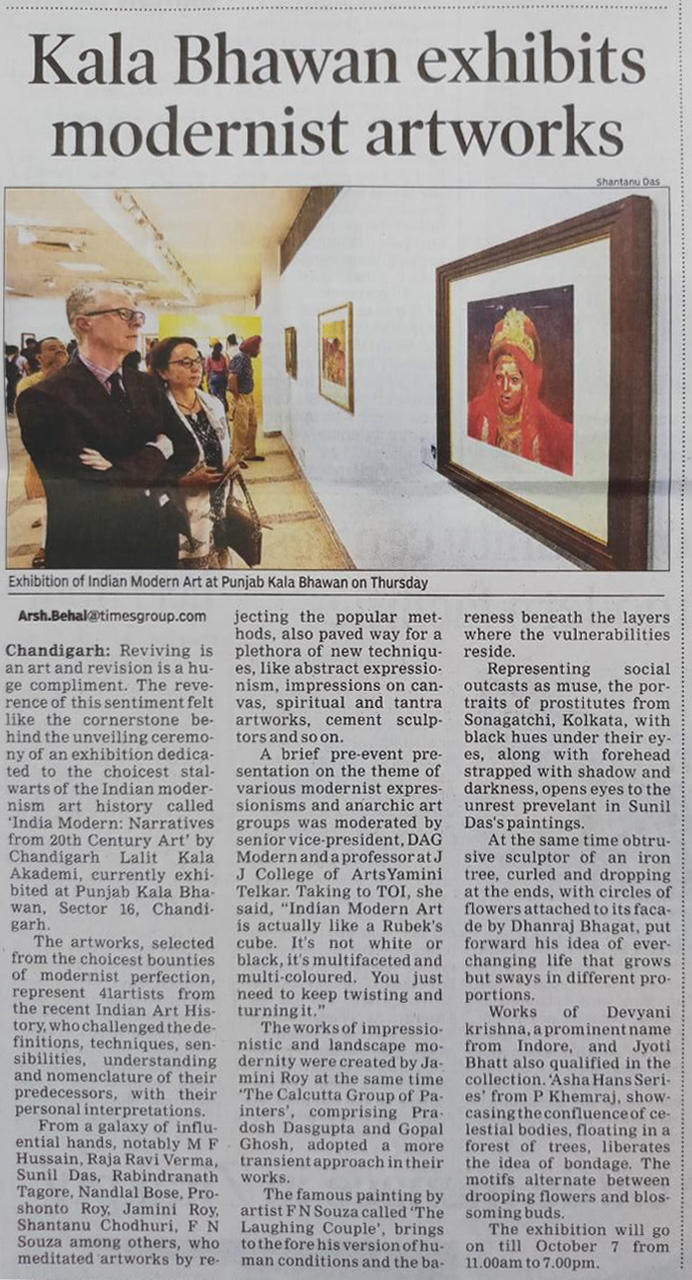Chandigarh: Reviving is an art and revision is a huge compliment. The reverence of this sentiment felt like the cornerstone behind the unveiling ceremony of an exhibition dedicated to the choicest stalwarts of the Indian modernism art history called ‘India Modern: Narratives from 20th Century Art’ by Chandigarh Lalit Kala Akademi, currently exhibited at Punjab Kala Bhawan, Sector 16, Chandigarh.
The artworks, selected from the choicest bounties of modernist perfection, represent 41artists from the recent Indian Art History, who challenged the definitions, techniques, sensibilities, understanding and nomenclature of their predecessors, with their personal interpretations.
From a galaxy of influential hands, notably M F Hussain, Raja Ravi Verma, Sunil Das, Rabindranath Tagore, Nandlal Bose, Proshonto Roy, Jamini Roy, Shantanu Chodhuri, F N Souza among others, who meditated artworks by rejecting the popular methods, also paved way for a plethora of new techniques, like abstract expressionism, impressions on canvas, spiritual and tantra artworks, cement sculptors and so on.
A brief pre-event presentation on the theme of various modernist expressionisms and anarchic art groups was moderated by senior vice-president, DAG Modern and a professor at J J College of ArtsYamini Telkar. Taking to TOI, she said, “Indian Modern Art is actually like a Rubek’s cube. It’s not white or black, it’s multifaceted and multi-coloured. You just need to keep twisting and turning it.”
The works of impressionistic and landscape modernity were created by Jamini Roy at the same time ‘The Calcutta Group of Painters’, comprising Pradosh Dasgupta and Gopal Ghosh, adopted a more transient approach in their works.
The famous painting by artist F N Souza called ‘The Laughing Couple’, brings to the fore his version of human conditions and the bareness beneath the layers where the vulnerabilities reside.
Representing social outcasts as muse, the portraits of prostitutes from Sonagatchi, Kolkata, with black hues under their eyes, along with forehead strapped with shadow and darkness, opens eyes to the unrest prevelant in Sunil Das’s paintings.
At the same time obtrusive sculptor of an iron tree, curled and dropping at the ends, with circles of flowers attached to its facade by Dhanraj Bhagat, put forward his idea of ever-changing life that grows but sways in different proportions.
Works of Devyani krishna, a prominent name from Indore, and Jyoti Bhatt also qualified in the collection. ‘Asha Hans Series’ from P Khemraj, showcasing the confluence of celestial bodies, floating in a forest of trees, liberates the idea of bondage. The motifs alternate between drooping flowers and blossoming buds.
The exhibition will go on till October 7 from 11.00am to 7.00pm.
Chandigarh: Reviving is an art and revision is a huge compliment. The reverence of this sentiment felt like the cornerstone behind the unveiling ceremony of an exhibition dedicated to the choicest stalwarts of the Indian modernism art history called ‘India Modern: Narratives from 20th Century Art’ by Chandigarh Lalit Kala Akademi, currently exhibited at Punjab Kala Bhawan, Sector 16, Chandigarh.
The artworks, selected from the choicest bounties of modernist perfection, represent forty one artistes from the recent Indian Art History, who challenged the definitions, techniques, sensibilities, understanding and nomenclature of their predecessors, with their personal interpretations.
From a galaxy of influential hands, notably M.F Hussain, Raja Ravi Verma, Sunil Das, Rabindranath Tagore, Nandlal Bose, Proshonto Roy, Jamini Roy, Shantanu Chodhuri, F.N Souza among more, who meditated artworks by rejecting the popular methods, also paved way for a plethora of new techniques, like abstract expressionism, impressions on canvas, spiritual and tantra artworks, cement sculptors etc.
A brief pre-event presentation on the theme of various modernist expressionisms and anarchic art groups was moderated by Yamini Telkar, Senior Vice President, DAG Modern and a professor at J.J College of Arts. Taking to TOI, she said, “Indian Modern Art is actually like a Rubek’s cube. It’s not white or black, it’s multifaceted and multi-coloured. You just need to keep twisting and turning the cube.”

